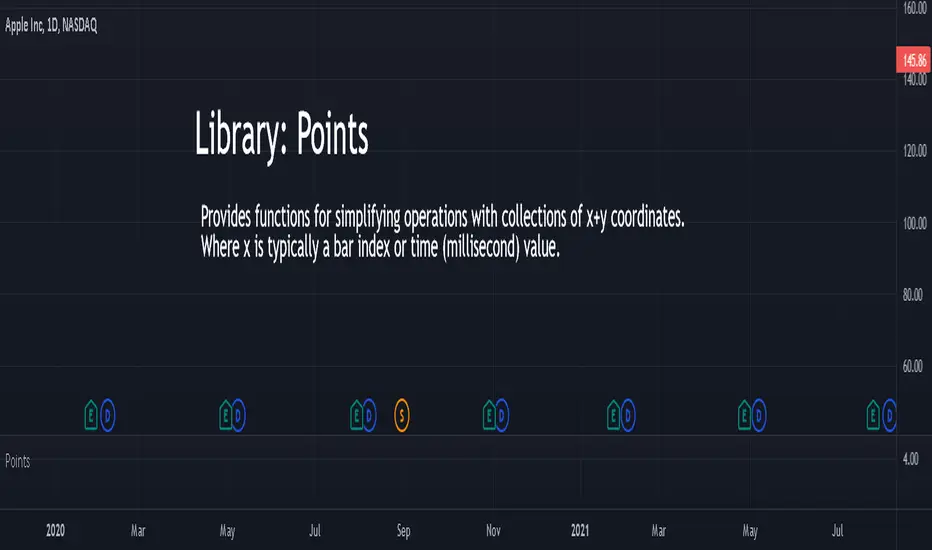Points

Provides functions for simplifying operations with collections of x+y coordinates. Where x is typically a bar index or time (millisecond) value.
new(size) Creates two arrays. One for X (int[]) and another for Y (float[]).
Parameters:
size: The initial size of the arrays.
size(xA, yA) Checks the size of the arrays and if they're equal returns the size.
Parameters:
xA: The X array.
yA: The Y array.
get(xA, yA, index) Gets the X and Y values of the arrays at the index.
Parameters:
xA: The X array.
yA: The Y array.
index: The index.
Returns: [x, y]
set(xA, yA, index, x, y) Sets the X and Y values of the arrays at the index.
Parameters:
xA: The X array.
yA: The Y array.
index: The index.
x: The x value.
y: The y value.
Returns: [index, x, y]
push(xA, yA, x, y) Adds X and Y values to the end of the arrays (as the last element).
Parameters:
xA: The X array.
yA: The Y array.
x: The x value.
y: The y value.
Returns: [index, x, y]
unshift(xA, yA, x, y) Adds X and Y values to the beginning of the arrays (as the first element).
Parameters:
xA: The X array.
yA: The Y array.
x: The x value.
y: The y value.
Returns: [index, x, y]
insert(xA, yA, index, x, y) Inserts X and Y values to the arrays at the index.
Parameters:
xA: The X array.
yA: The Y array.
index: The index to insert at.
x: The x value.
y: The y value.
Returns: [index, x, y]
pop(xA, yA) Removes the last element from the arrays and returns their value.
Parameters:
xA: The X array.
yA: The Y array.
Returns: [x, y]
shift(xA, yA) Removes the first element from the arrays and returns their value.
Parameters:
xA: The X array.
yA: The Y array.
Returns: [x, y]
remove(xA, yA) Removes the element from the arrays at the index and returns their value.
Parameters:
xA: The X array.
yA: The Y array.
Returns: [x, y]
first(xA, yA) Gets the X and Y values of the first element.
Parameters:
xA: The X array.
yA: The Y array.
Returns: [x, y]
last(xA, yA) Gets the X and Y values of the last element.
Parameters:
xA: The X array.
yA: The Y array.
Returns: [x, y]
allIndexesBetween(xA, lo, hi, start, ordered) Gets the indexes that have values at or above the low value and below the high value.
Parameters:
xA: The X array.
lo: The inclusive low value.
hi: The excluded hi value.
start: The optional index to start the backwards search.
ordered: If true, the search ends when the first value is found that is less than the low.
lastIndexBetween(xA, lo, hi, start, ordered) Gets the first found from the end that has a value at or above the low value and below the high value.
Parameters:
xA: The X array.
lo: The inclusive low value.
hi: The excluded hi value.
start: The optional index to start the backwards search.
ordered: If true, the search ends when the first value is found that is less than the low.
lastIndexBelow(xA, hi, start) Gets the first found from the end that has a value below the high value.
Parameters:
xA: The X array.
hi: The excluded hi value.
start: The optional index to start the backwards search.
Added:
add(xA, yA, x, y) Inserts the X and Y values into the arrays based upon the X value assuming the the arrays is ordered by X.
Parameters:
xA: The X array.
yA: The Y array.
x: The x value.
y: The y value.
Returns: [index, x, y]
Biblioteca Pine
Fiel al espíritu de TradingView, el autor ha publicado este código de Pine como biblioteca de código abierto, para que otros programadores Pine de nuestra comunidad puedan reutilizarlo. ¡Enhorabuena al autor! Puede usar esta biblioteca de forma privada o en otras publicaciones de código abierto, pero la reutilización de este código en publicaciones está sujeta a nuestras Normas internas.
Exención de responsabilidad
Biblioteca Pine
Fiel al espíritu de TradingView, el autor ha publicado este código de Pine como biblioteca de código abierto, para que otros programadores Pine de nuestra comunidad puedan reutilizarlo. ¡Enhorabuena al autor! Puede usar esta biblioteca de forma privada o en otras publicaciones de código abierto, pero la reutilización de este código en publicaciones está sujeta a nuestras Normas internas.